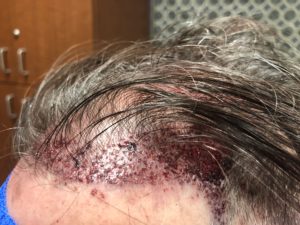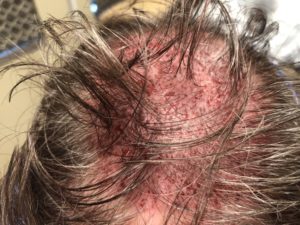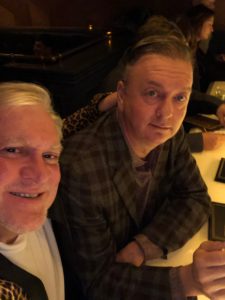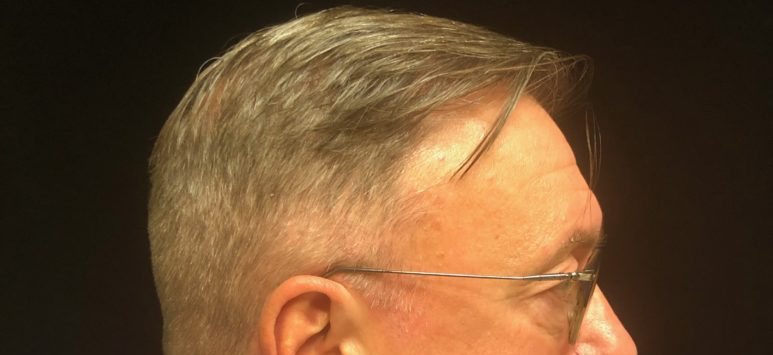
The Doctor Becomes the Patient: Dr. Slack’s Experience with Neograft Hair Restoration
I started thinking about it about three or four years ago. I began to notice that I could see the light shining through my hair when I was looking in the mirror. I didn’t really notice any specific bald spots, but certainly my hair was thining and my hairline was receding a little bit. Having two teenage boys with really thick full hair I thought, “Hey I could be that person again.”
This is how Dr. Slack’s own story of undergoing Neograft® Hair Restoration began. But things got serious after grabbing a snack at the hospital one day.
I was paying for a bag of chips at a self-service snack bar in our hospital when I noticed a man on the kiosk security screen. He was wearing my clothes and had a rather large bald spot on the back of his head. I turned around hoping to see someone dressed like me, but I was all alone… just me and my bald spot.
This is the moment that led Dr. Slack to research the latest technology in hair restoration. During his plastic surgery training in the 90s, the “strip method” was used. The surgeon removed a big strip of scalp off the back of the head. They sewed the wound up, but it often left a noticeable scar. Then they chopped up the strip and implanted it as “plugs.” These often had an unnatural look, and recovering from the procedure was painful. Dr. Slack knew he wasn’t interested in that approach – for himself or his patients. But his research revealed a major advancement in hair restoration in a method called Follicular Unit Extraction (FUE).
With FUE, individual hair follicles are harvested one by one, and implanted one by one. There is no noticeable scarring and the pain is much less than the other, older methods out there. In addition, the fact that follicles are placed individually allows for a far more natural look than could previously be expected with a hair transplant. Dr. Slack explains, “It’s truly an art form, and it’s totally different than the way I was taught to do it.”
Neograft® is a company that developed a medical device to individually harvest and collect hair follicles. So, even though it is called the Neograft® procedure, Neograft® is just a tool used to simplify the FUE method for harvesting hair follicles.
Dr. Slack eventually opted to include Neograft® in his practice (and to use it for his own hair restoration) because he felt they offered the best technology and expertise for success. One aspect that means a great deal to Dr. Slack and his patients is that Neograft® sends Hair Transplant Technicians with a minimum of five to ten years experience to help conduct each hair restoration procedure.
Before a patient undergoes a Neograft® procedure, Dr. Slack visits with them to make sure they’re good candidates. Some people aren’t. Maybe they are young people who are likely to lose a lot more hair, or perhaps they have lost so much hair that there is not enough donor hair left to transplant in order to achieve the kind of result they are looking for. “I’ve turned more people away than I’ve accepted because some are just not good candidates. I would rather them spend their money on something else instead of spending it on a hair transplant that won’t give them the look they are seeking.”
For himself, Dr. Slack prepared for the procedure about a month in advance.
The back of your head has to be shaved so they can see the individual follicles. This look kind of looks awful. Having normal length hair everywhere else and then just a straight shave in the back – it’s the classic chili bowl cut. I decided to have my barber kind of do a fade cut about 10 days before my procedure. She wouldn’t cut it as close as I needed it cut, but at least it blended in better after the procedure and didn’t look quite so ridiculous. It also allowed people I knew to get used to my shorter hair cut before I actually had the procedure. To be honest, I would have never walked in and asked for that kind of hair cut but I actually liked it.
Dr. Slack recommends that his patients do the same before hair restoration. Getting a haircut that will work well with the shaved part of your head will make things less obvious.
Besides his hairstyle, Dr. Slack started thinking about pain control. As a plastic surgeon, his patients’ comfort is always on his mind, but things are a bit different when planning for your own pain control.
The only thing I was worried about was having to get the numbing shots in the back of the head. Local anesthetics (lidocaine or Marcaine) are injected into the back of the scalp wherever the grafts are going to be implanted. I didn’t really relish the idea of multiple needle sticks but they were surprisingly not that big of a deal. A little a vibrating device is used to “distract” the nerves during the injections, so it wasn’t nearly as bad as I thought it was going to be. Some people may want to take a small dose of valium or hydrocodone prior to the surgery, but I couldn’t really prescribe them for myself legally. I didn’t really need them anyway.
Once his head was numbed, Dr. Slack was ready for his procedure to begin. The entire thing, from harvesting to implanting the follicles took about eight hours. The first few hours, when the follicles were being removed from the back of his head, weren’t too bad.
I was face down on a massage table when they were harvesting from the back of my head, and I would lie on my side one way or the other when they were harvesting from the sides. When I was on my side I just slept. When I was on my stomach I was on my phone, since there is a hole cut out in the head rest you can look through. I surfed the internet, answered emails and watched Netflix. So that was no big deal.
The part that was a big deal was simply being in a chair for so long. Dr. Slack appreciated taking a break to check emails and stretch his legs and a longer break to get lunch after the follicles had been harvested.
I came back to my office – we ordered from Jason’s Deli. I had a nice corn beef sandwich and some soup. The technicians had a little lunch break, too. It felt good to get up and move around and not be in the chair.
However, Dr. Slack found the next step – implanting the follicles – to be the most difficult. They had to access his hairline in the front and the bald spot on the back, so he was propped upright by pillows. He admits he found this uncomfortable after a while.
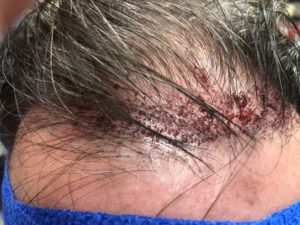
When they’re putting the hairs in, you’re just sitting up in the chair and they’re putting them in wherever they need to put them in so you can watch TV. We’ve got an iPad stand that you can use so you can watch Netflix or something else during the implantation. That’s the only time for me it got tedious. In that last hour, I was ready to be done and felt kind of uncomfortable sitting in basically one position for so long.
Once the procedure was complete, Dr. Slack was able to drive himself home since he had not taken any Valium or Hydrocodone. He had a light bandage on his head, and sat up and watched the Mavericks game, using a little Tylenol for pain. The next morning he washed his hair according to the same instructions he gives his patients – pouring soapy water over his head and then pouring more water over it to rinse. No rubbing or scrubbing.
I’d say the biggest problem for me was finding a comfortable position to sleep in. If you put the grafts in the back of your head to cover a bald spot, you can’t lay on the back of your head or you’ll dislodge your grafts. So the recommendation is you sleep with your head a little propped up off your pillow. I used one of those airplane pillow that goes around your neck, and I just couldn’t get comfortable. It was really hard to sleep that first night but it got better the following nights.
Over the next few days, Dr. Slack was prepared for what to expect from his experience with is own patients.
I knew I could go back to work in a couple days if I wasn’t self conscious about having some bruising, eye swelling, and maybe some scabbing. I went back to work and saw patients two days after I had the procedure, and did surgery a couple days later. Remarkably, nobody ever really commented on how I looked unless I pointed it out to them.
Dr. Slack did experience swelling around his eyes at day three or four, but that wasn’t too bad for him, as there was minimal pain. He was able to manage the discomfort with Tylenol, and he says, “it was not a bad recovery at all.”
Dr. Slack likes to remind everyone that the follicles will grow hair a little at first, but not to get too excited – this hair will fall out and it will take about eight months for the follicles to come out of their dormant state and begin growing new hair for good. This was Dr. Slack’s own experience and it’s been the experience of his patients, too. Even so, it didn’t prevent him from enjoying himself.
It isn’t Amazon prime. It’s not going to be on your doorstep tomorrow morning. You really can’t judge the results for about a year or so. But by two weeks I went on a boys’ trip to Detroit to watch the Cowboys and the Michigan games. I didn’t feel self-conscious one bit, and it didn’t look like I had anything done. I was fine.
Men don’t come in for a lot of procedures. They may come in for Botox, or maybe some liposuction, but clearly what bugs men the most is not having their hair.
It was the same for Dr. Slack, and he seems to have found a solution to offer his patients that worked for him, too.


